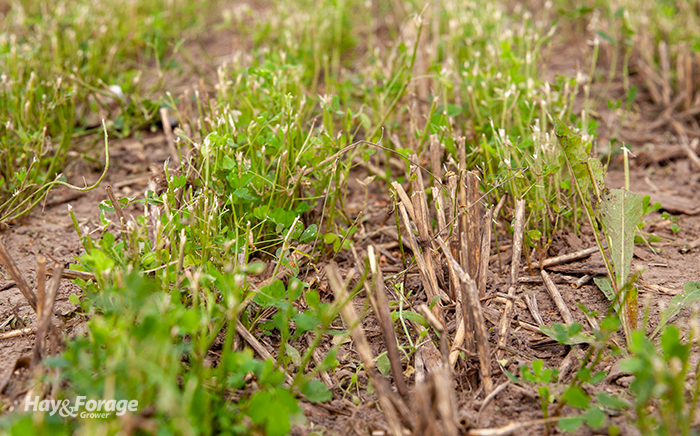Seed alfalfa green this spring |
| By Amber Friedrichsen, Managing Editor |
|
|
 Alfalfa seedbeds are typically prepared with tillage and a cultipacker to reduce residue and create a smooth soil surface, but this can leave fields more susceptible to erosion. One alternative is to plant alfalfa into a standing companion crop like cereal rye. In a Forage Focus webinar hosted by the University of Wisconsin Division of Extension, Josh Kamps discussed this type of green seeding. The regional crops educator in southern Wisconsin noted that even though doing so has resulted in a slight alfalfa yield reduction during the establishment year, stand establishment has been successful overall, and there are other agronomic benefits to be gained. A cereal rye canopy essentially provides protection to alfalfa seedlings, especially in the face of adverse spring weather. Cereal rye can also suppress weeds, reducing competition for the young alfalfa plants. From a soil health perspective, utilizing a standing companion crop can mitigate water runoff and nutrient loss that could otherwise occur on a bare seedbed. Best practices The best practices for seeding alfalfa green into cereal rye are not unlike those for any other type of establishment. Kamps said farmers should identify which stands are scheduled for rotation in the fall and adjust soil fertility and pH accordingly before seeding cereal rye. He has found a seeding rate of 1 to 1.5 bushels is ideal. “If you’re looking to have that cereal rye as a forage crop, maybe seed a little higher at 1.5 bushels per acre. If you are only utilizing it as a cover crop, a [lower seeding rate] is sufficient,” he said. Come spring, Kamps recommended farmers seed alfalfa into cereal rye as soon as soil moisture and temperature is fit. In his southern Wisconsin trials, this has generally been in early April. Regardless, the stage of cereal rye maturity is less important to alfalfa establishment than optimal soil condition. If chopping cereal rye for feed is the goal, aim to harvest crops around boot stage. Kamps suggested raising the cutting height slightly higher than alfalfa seedlings. Chemically terminating cereal rye is another option, which should be delayed until alfalfa plants have three to four trifoliate leaves. “Think about the herbicides you’re using and if the weather is adequate at the time you’re going to apply them,” Kamps advised. For his research, he’s generally used glyphosate, but he said some alfalfa varieties may require other options. Soil savings To dive deeper into the effects green seeding can have on soil health, Kamps performed a soil dislodgement test in alfalfa stands that were established three ways: alfalfa seeded green into cereal rye, alfalfa no-till drilled after cereal rye burndown, and alfalfa seeded into a tilled seedbed. The soil dislodgement test essentially quantified rain drop impact in the stands. Kamps laid out soil mats for two weeks following alfalfa establishment, during which the fields received 1.5 inches of rain. Then, he measured how much soil splashed onto the mats and calculated the average pounds of dislodged soil per acre. Approximately 350 pounds of soil was dislodged per acre where alfalfa was seeded green, whereas nearly twice as much (660 pounds per acre) was dislodged where alfalfa was no-till drilled into terminated cereal rye. In stands where alfalfa was seeded into tilled seedbeds, Kamps estimated 1,470 pounds of soil was dislodged per acre — more than four times more than the green-seeded stand. “That’s not to say the soil would have left the field, but it entered that first stage of soil erosion, breaking apart from the soil aggregate where it was being held,” Kamps asserted. |
